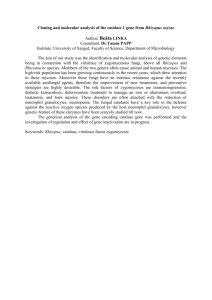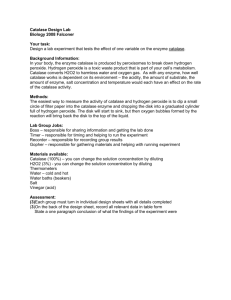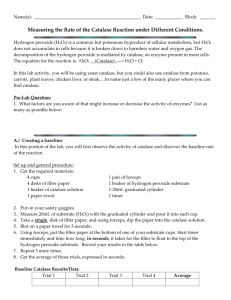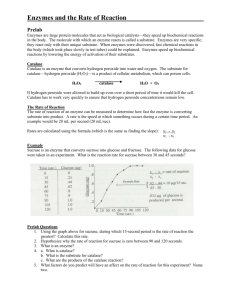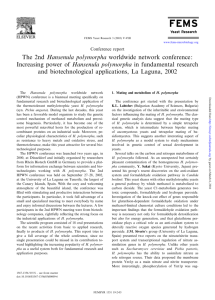Designing Hansenula polymorpha as a Biocatalyst for the Oxidation
advertisement
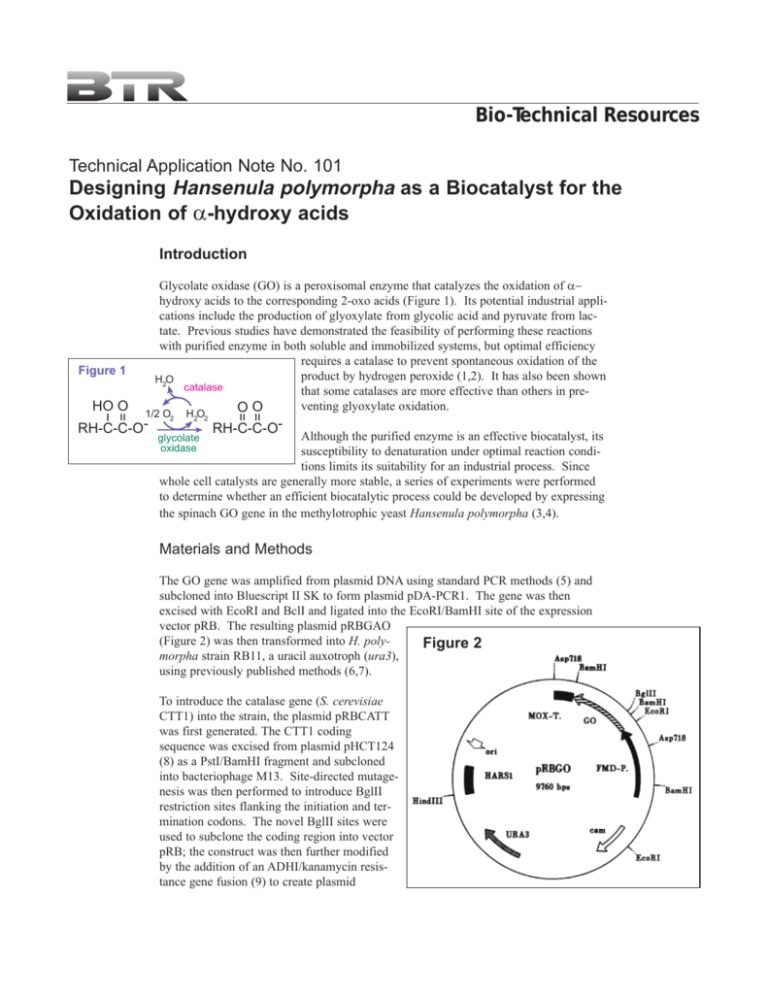
Bio-Technical Resources Technical Application Note No. 101 Designing Hansenula polymorpha as a Biocatalyst for the Oxidation of α-hydroxy acids Introduction Figure 1 1/2 O2 RH-C-C-O- H2O2 = = = HO O Glycolate oxidase (GO) is a peroxisomal enzyme that catalyzes the oxidation of α− hydroxy acids to the corresponding 2-oxo acids (Figure 1). Its potential industrial applications include the production of glyoxylate from glycolic acid and pyruvate from lactate. Previous studies have demonstrated the feasibility of performing these reactions with purified enzyme in both soluble and immobilized systems, but optimal efficiency requires a catalase to prevent spontaneous oxidation of the product by hydrogen peroxide (1,2). It has also been shown H2O catalase that some catalases are more effective than others in preventing glyoxylate oxidation. OO RH-C-C-O- Although the purified enzyme is an effective biocatalyst, its susceptibility to denaturation under optimal reaction conditions limits its suitability for an industrial process. Since whole cell catalysts are generally more stable, a series of experiments were performed to determine whether an efficient biocatalytic process could be developed by expressing the spinach GO gene in the methylotrophic yeast Hansenula polymorpha (3,4). glycolate oxidase Materials and Methods The GO gene was amplified from plasmid DNA using standard PCR methods (5) and subcloned into Bluescript II SK to form plasmid pDA-PCR1. The gene was then excised with EcoRI and BclI and ligated into the EcoRI/BamHI site of the expression vector pRB. The resulting plasmid pRBGAO (Figure 2) was then transformed into H. polyFigure 2 morpha strain RB11, a uracil auxotroph (ura3), using previously published methods (6,7). To introduce the catalase gene (S. cerevisiae CTT1) into the strain, the plasmid pRBCATT was first generated. The CTT1 coding sequence was excised from plasmid pHCT124 (8) as a PstI/BamHI fragment and subcloned into bacteriophage M13. Site-directed mutagenesis was then performed to introduce BglII restriction sites flanking the initiation and termination codons. The novel BglII sites were used to subclone the coding region into vector pRB; the construct was then further modified by the addition of an ADHI/kanamycin resistance gene fusion (9) to create plasmid pRBCATT (Figure 3). Selected clones expressing GO were then re-transformed with this plasmid and selected by G418 resistance. Figure 3 Tube and shake flask cultures were grown at 37°C in yeast nutrient broth (YNB; 0.14% w/v Difco YNB and 0.5% ammonium sulfate) supplemented with 2% (w/v) glycerol for culture growth. GO and CTT expression was initiated by promoter derepression (0.2% (w/v) glycerol) or induction (1% methanol). Crude extracts were prepared by centrifuging the cells for 5 min at 800 g and resuspending them in 0.1 M NaPi buffer, pH 8.3, containing 1 mM DTT, 0.1 mM FMN, 10 mM PMSF, and 10% w/v DMSO. After breaking the cells with glass beads, cell debris was removed by centrifugation for 15 min at 15,000 g (4°C). Results Characterization of GO-Producing H. polymorpha Strains Competent cells of strain RB11 were transformed with the GO-containing plasmid pRBGAO. Several hundred transformants were selected, passaged, and analyzed for glycolate oxidase activity using a colorimetric assay. After the first round of screening, enzyme titers between 2913 and 7524 mU/mg were obtained. The transformant exhibiting the highest activity was then subcloned. One subclone chosen for further study, desigFigure 4 nated GO1, was determined to have approxiDry Weight (g/L) GO Activity (U/g) mately 30 integrated copies of the plasmid. 300 100 The transformed yeast strain was grown in a Biomass 10-liter culture in a medium composed of GO Pepton 190 (2 g/L) yeast extract (1 g/L) Pepton 10 5 (3 g/L) YNB (1.4 g/L) ammonium sulfate (5 g/L) and potassium dihydrogen sulfate (0.6 g/L) containing 3% (w/v) glycerol. Once sterilized, the fermentor was inoculated with a 21 liter overnight culture. Culture conditions were pH 5.0, 30°C, aeration at 10 l/min, agitation at 500 rpm. Glycerol concentration was monitored and, once consumed, it was added in a 0 PO2 controlled feed to keep the concentration 0 10 20 30 40 50 between 0.1% and 0.4% for 24 hours (promoter Time (hr) derepression phase). Promoter induction was then initiated with a feed containing 50% methanol, 1% glycerol, YNB, and various salts and vitamins. Yields of roughly 240 U/g wet weight cells were obtained, with GO representing 14% of soluble intracellular protein (Figure 4). Glycolate oxidase was found to be primarily located in peroxisomes, so <1% of the enzyme was accessible for the bioconversion reaction in whole cell preparations. A simple incubation step in phosphate buffer containing 0.1% Triton X-100, benzalkonium 250 200 150 100 50 0 60 70 chloride or Barquat MB-50 was sufficient to permeabilize the cells without causing significant leakage through the cell wall. This procedure was therefore adopted as a standard part of the preparation. Oxidation of L-lactate An aqueous solution containing 0.5 M sodium L-lactate, 0.1 M isobutyric acid (HPLC internal standard), 6.0 IU/ml soluble spinach GO, and 10,000 IU/ml soluble catalase (Aspergillus niger) was placed in a reaction vessel and adjusted to pH 9.0 with NaOH. After 5 hr the yields of pyruvate and acetate were 95.3% and 0.9%, with 4.5% of the lactate remaining (Table 1). The catalase activity remained constant throughout the reaction, while the GO activity fell to 68% of its original value. The H. polymorpha catalyst was prepared as described above. A biocatalyst was also prepared from a GO-expressing strain of P. pastoris using the same method. The construction of this strain and procedures for fermentation have been described. Reaction conditions were essentially the same as those used for the purified enzymes, but an aliquot of permeabilized cells Table 1: Comparison of GO Catalysts in Lactate Oxidation replaced the GO and catalase. GO Catalase Lactate Pyruvate Acetate The performance of the whole Catalyst (IU/ml) (IU/ml) (%) (%) (%) cell catalysts was found to be superior to that of the soluble Sol. enzymes 6.0 10,000 0.9 95 4.5 enzymes, even when only one H. polymorpha 6.5 5,000 0.4 97 2.5 half of the catalase activity was P. pastoris 1.1 2,500 3.3 93 5.0 present (Table 1). The higher P. pastoris 2.3 5,000 0.4 97 2.3 yield of pyruvate obtained with P. pastoris 6.5 10,100 0.4 99 0.7 both the H. polymorpha and P. pastoris catalysts appeared to be due to a decrease in oxidation by H202, since the amount of acetate is correspondingly lower. The results obtained with H. polymorpha and with P. pastoris at 5,000 and 10,000 U/ml catalase suggests that the catalase may be limiting even with the cellular catalysts. Conversion of Glycolate Table 2: Yield of Glyoxylate from Glycolate Oxidase Expressing Strains Strain Reaction Glyoxylate (% yield) GO1 1 2 3 4 97.6 97.3 98.0 98.0 GO1/GTT 1 2 3 4 98.8 98.8 99.8 100 For the production of glyoxylate, optimum yields require the addition of an amine. A typical bioconversion reaction was performed as follows: First, a 100 ml aqueous solution of 0.75 M glycolic acid, 0.863 M ethylenediamine (EDA), and 0.1 M isobutyric acid (as an internal standard for HPLC analysis) was adjusted to pH 8.9 and cooled to 5°C in a 300-ml stirred reactor. A sample of permeabilized GO1 cells (equivalent to 5 g wet weight, 880 U GO and 453,000 U catalase) was then added. The reaction was performed with stirring (100 rpm) under 1.7 MPa oxygen pressure at 5°C. Aliquots were withdrawn regularly to monitor substrate and product concentrations. As shown in Table 2, yields of glyoxylate were >97% when ethylenediamine was used. Furthermore, it was possible to recover the biocatalyst by brief centrifugation and to reuse it in up to 25 successive reactions with little loss of enzyme activity or product yield. Characterization of GO/CTT1-Coexpressing Strains One of the advantages of the H. polymorpha expression system is the ability to overexpress more than one heterologous gene and to select the gene ratio giving optimal performance. A strain was therefore generated expressing both GO and catalase T from S. cerevisiae (CTT1). Strain GO1 was transformed with plasmid pRBCATT (Figure 3), and transformants were selected by resistance to G418. Selected clones expressing high levels of CTT1 activity were found to have 2-25 copies of the CTT1 gene in addition to the 30 copies of GO. The three strains selected for further investigation harbored 10, 15, or 25 copies of the CTT1 expression cassette. The coexpressing strains were then evaluated for genetic stability under non-selective conditions. Cells were cultured in YPD and sampled after 100, 300, and 800 generations. DNA was then isolated and analyzed by Southern blot using a 32P-labeled FMD promoter probe. The copy number of each gene (GO and CTT) remained constant, and there were no observable changes in restriction patterns that would indicate genetic rearrangements. Oxidation of Glycolate A biocatalyst was prepared from the GO1/CTT strain according to the procedures described above. The results of reactions in which EDA was used as the amine indicated little effect of the heterologous catalase on the efficiency of glycolate conversion (Table 2). However, other applications requiring amines other than EDA were found to be significantly more efficient using the coexpressing strain. Discussion The experiments described here demonstrate the suitability of Hansenula polymorpha for applications involving biochemical conversions. Heterologous proteins can be expressed at high levels in a rapid fermentation scheme. The harvested cells can then be utilized as catalysts for the desired reaction. Although the applications discussed here required permeabilization of the cells, the procedure is very simple and can be performed in bulk directly after harvesting. The permeabilized cells can be stored indefinitely at -80°C without significant loss of enzyme activity. The use of whole cell catalysts circumvents some of the difficulties associated with the use of purified enzyme systems. The enzymes are generally more stable in the cellular environment, particularly when vigorous agitation and/or aeration is required. The catalysts are readily removed from the reaction mixture by centrifugation and can be used in numerous recycles without significant loss of enzyme activity. The ability to introduce more than one gene and to select the optimum ratio is a very powerful tool in biocatalysis, metabolic pathway engineering, and recombinant protein production. This versatility is one of the features making Hansenula polymorpha an attractive host for virtually any application. References 1. Seip JE, Fager SK, Gavagan JE, Gosser LW, Anton DL, DiCosimo R (1993) Biocatalytic production of glyoxylic acid. J Org Chem 58:2253-2259. 2. Seip JE, Fager SK, Gavagan JE, Anton DL, DiCosimo R (1994) Glyoxylic acid production using immobilized glycolate oxidase and catalase. Bioorg Med Chem 2:371-378. 3. Gellissen G, Piontek M, Dahlems U, Jenzelewski V, Gavagan JE, DiCosimo R, Anton DL, Janowica ZA (1996) Recombinant Hansenula polymorpha as a biocatalyst: coexpression of the spinach glycolate oxidase (GO) and the S. cerevisiae catalase T (CTT1) gene. Appl Microbiol Biotechnol 46:46-54. 4. Eisenberg A, Seip JE, Gavagan JE, Payne MS, Anton DL, DeCosimo R (1997) Pyruvic acid production using methylotrophic yeast transformants as catalyst. J of Molecular Catalysis B: Enzymatic 2:223-232. 5. Mullis KB, Faloona FA (1987) Specific synthesis of DNA in vitro via a polymerasecatalyzed chain reaction. Methods Enzymol 155:335-350. 6. Dohmen RJ,Strasser AWM, Honer CB, Hollenberg CP (1991) An efficient transformation procedure enabling long-term storage of competent cells of various yeast genera. Yeast 7:691-692. 7. Gellissen G, Janowicz ZA, Merckelbach A, Piontek M, Keup P, Weydemann U, Hollenberg CP, Strasser AWM (1991) Heterologous gene expression in Hansenula polymorpha: efficient secretion of glucoamylase. Biotechnology 9:291-295. 8. Spevack W, Fessl F, Rytka J, Tracyk A, Skoneczny M, Ruis H (1983) Isolation of the catalase T structural gene of S. cerevisiae by functional complementation. Mol Cell Biol 3:1545-1551. 9. Reiss B, Sprengel R, Schaller H (1984) Protein fusions with the kanamycin resistance gene from transposon Tn5. EMBO J 3:3317-3322. Bio-Technical Resources 1035 South Seventh Street, Manitowoc, Wisconsin USA 54220-5388 Email: info@biotechresources.com Web: http://www.biotechresources.com Phone: 920-684-5518 Fax: 920-684-5519

